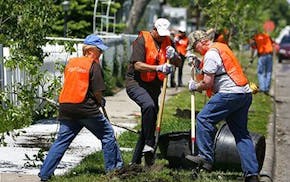Girl on the Leeside
By Kathleen Anne Kenney. (Doubleday/Nan A. Talese), 287 pages, $26.95.
Petite and dark-haired Siobhan Doyle is approaching 30 but is still something of a girl-child. Her mother was killed in an IRA bombing in Belfast, and since then Siobhan has spent her entire sheltered life living with her uncle in a village in the west of Ireland, where she has immersed herself in the poetry and folklore of her country. Though they are self-taught, she and her uncle both gain reputations as experts on ancient Irish poetry, and as the book opens a handsome scholar named Tim Ferris has arrived from America to learn from them. Of course Siobhan and Tim end up falling in love, but Siobhan is so unworldly she doesn't recognize the emotion for what it is. The plot of Minnesota writer Kathleen Kenney's romantic novel stretches credulity — is it possible to be so sheltered in this day and age, even in a remote village? Can Siobhan possibly be as naive as she seems? How would two self-educated poetry lovers gain international academic respect? But if you're willing to suspend your disbelief you might revel in the descriptions of the Irish landscape, the snippets of poetry (from Seamus Heaney to William Butler Yeats to the ancients) and the satisfying — and surprising — story of love.
Kathleen Kenney will be at Common Good Books at 7 p.m. on July 26.
LAURIE HERTZEL
The Road to Jonestown
By Jeff Guinn. (Simon & Schuster, 531 pages, $28.)
As a hopeful college graduate in my first journalism job in 1978, I was horrified when the wires moved reports of the murder-suicide of 900 members of a religious cult in the jungles of Guyana. It stayed in the headlines for months as the media tried to pick apart how such a thing could happen. Babies. Teenagers. Men and women. Drinking a Kool-Aid drink laced with cyanide and knowing they would die, with armed guards standing by to make sure they did.
Historian/author Jeff Guinn, known for his brilliant biographies of Charles Manson and Bonnie and Clyde, writes the definitive back story on cult leader Jim Jones' rise to power. He tracks the movement's beginnings in Indianapolis in 1955 as Jones, a minister who preached the Bible with a heavy overlay of socialism, attracted followers who just wanted an equal and dignified life for all. Embracing civil rights in the turbulent '50s and '60s, Jones recruited well-meaning followers with promises of collective spiritual wealth, forming one of the earliest racially integrated churches. He called Peoples Temple his "rainbow family."
Guinn conducted exhaustive research on what led Jones to move his congregation first to Northern California, where he gained political traction, and then abruptly (you'll learn why) to South America, where he founded a utopian commune in his name. Guinn reveals sordid details of life in Jonestown, mined from FBI reports and other new sources, involving communal sex, extortion, psychological warfare and drug abuse.
This is so much more than a biography of a minister-turned-megalomaniac. It's a chronicle of the times, when people grasped at hope and happiness in unexpected places. And it's a chilling portrait of a man who, when the curtain was dropping on his slice of heaven, took everyone down with him.
GINNY GREENE

Yuen: Why do people forgive? It's messy, complex and 'the best form of self-interest'

Critics' picks: The 12 best things to do and see in the Twin Cities this week
How the Goo Goo Dolls learned the music biz from Minneapolis bands
